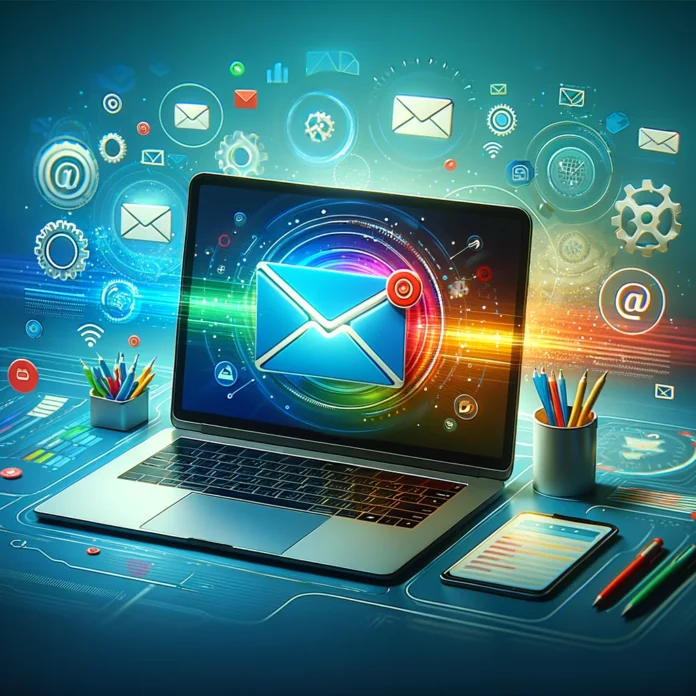Create your very own Auto Publish News/Blog Site and Earn Passive Income in Just 4 Easy Steps
Email marketing automation has become an essential tool for email marketers in today’s fast-paced digital landscape. By leveraging automation technology, marketers can streamline their email campaigns, increase efficiency, and deliver personalized content to their subscribers. In this article, we will explore the key elements, best practices, and common challenges associated with email marketing automation.
Understanding Email Marketing Automation
Defining Email Marketing Automation
In simple terms, email marketing automation refers to the use of software to automate various aspects of your email campaigns. It allows you to send targeted and timely messages to your subscribers based on their behavior, preferences, and interactions with your brand.
Imagine having the ability to reach out to your audience at the perfect moment, delivering the right message to the right person, without having to send each email manually. With email marketing automation, this becomes a reality. By utilizing sophisticated software, you can set up triggers and rules that determine when and how your emails are sent, ensuring that your subscribers receive the most relevant and personalized content.
For example, let’s say you have an online store and a customer adds an item to their cart but doesn’t complete the purchase. With email marketing automation, you can automatically send them a reminder email, enticing them to come back and complete their purchase. This level of personalization and automation not only saves you time and effort but also increases the likelihood of converting potential customers into paying ones.
Benefits of Email Marketing Automation
The benefits of implementing email marketing automation are manifold. Firstly, it saves you time and effort by eliminating the need for manual intervention in every step of your email marketing process. Instead of spending hours crafting and sending individual emails, you can set up automated workflows that handle the entire process for you. This frees up your time to focus on other important aspects of your business.
Moreover, email marketing automation enables you to deliver highly relevant and personalized content to your subscribers. By segmenting your audience based on their preferences, behavior, and demographics, you can tailor your messages to their specific needs and interests. This level of personalization not only increases engagement but also improves the chances of conversions. When your subscribers receive emails that resonate with them, they are more likely to take the desired action, whether it’s making a purchase, signing up for a webinar, or downloading a resource.
Lastly, automation provides valuable insights into your subscribers’ behavior. With the data collected through automation, you can analyze and understand how your audience interacts with your emails. You can track open rates, click-through rates, and conversion rates to gain a deeper understanding of what works and what doesn’t. This data-driven approach allows you to refine your email marketing strategies, optimize your campaigns, and ultimately improve your return on investment (ROI).
In conclusion, email marketing automation is a powerful tool that can revolutionize your email campaigns. By leveraging automation, you can save time, deliver personalized content, and gain valuable insights into your subscribers’ behavior. So why wait? Start exploring the world of email marketing automation and unlock the full potential of your email campaigns today.
Key Elements of Email Marketing Automation
Email marketing automation is a powerful tool that allows businesses to streamline their email marketing efforts and deliver personalized content to their subscribers. By leveraging key elements such as email list segmentation, triggered emails, and drip campaigns, businesses can enhance their email marketing strategy and drive better results.
Email List Segmentation
Segmenting your email list is crucial for effective email marketing automation. By dividing your subscribers into distinct groups based on their demographics, preferences, or past interactions, you can deliver highly targeted and relevant content. For example, if you have an e-commerce store, you can segment your list based on the products or categories that your subscribers have shown interest in. This targeted approach increases open rates, click-through rates, and ultimately, conversions.
Moreover, email list segmentation allows you to tailor your messaging to specific segments of your audience. You can create personalized offers, recommendations, or promotions that resonate with each segment’s unique needs and preferences. This level of personalization not only improves the subscriber experience but also increases the likelihood of engagement and conversion.
Triggered Emails
Triggered emails are sent automatically to subscribers based on predefined triggers or actions they take. These triggers could include signing up for your newsletter, abandoning a shopping cart, or completing a purchase. By carefully mapping out your triggers and automating the corresponding email sequences, you can provide timely and tailored content that nurtures your leads and drives conversions.
For instance, if a subscriber abandons their shopping cart, you can set up a triggered email sequence that reminds them of the items they left behind and offers an incentive to complete the purchase. This personalized follow-up can significantly increase the chances of converting an abandoned cart into a sale.
Triggered emails can also be used to welcome new subscribers, deliver exclusive content or promotions, and re-engage inactive subscribers. By leveraging the power of automation, you can ensure that your subscribers receive the right message at the right time, increasing their engagement and loyalty to your brand.
Drip Campaigns
A drip campaign is a series of automated emails sent at regular intervals to nurture leads and guide them through the customer journey. Drip campaigns are designed to provide valuable information, build trust, and gently nudge subscribers toward making a purchase.
For example, if you offer a free e-book or a webinar, you can set up a drip campaign that delivers additional related content over some time. This allows you to establish your expertise, provide value to your subscribers, and gradually move them closer to making a purchase decision.
By creating compelling and well-timed email sequences, you can keep your brand top-of-mind and drive engagement with your audience. Drip campaigns can be customized based on various factors such as subscriber behavior, preferences, or stages in the customer journey. This level of personalization helps you build stronger relationships with your subscribers and increases the likelihood of conversion.
In conclusion, email marketing automation offers businesses a powerful way to enhance their email marketing strategy. By leveraging key elements such as email list segmentation, triggered emails, and drip campaigns, businesses can deliver personalized and relevant content to their subscribers, increasing engagement, and driving conversions.
Best Practices for Email Marketing Automation
Email marketing automation has revolutionized the way businesses communicate with their subscribers. By leveraging the power of technology, marketers can now deliver personalized and targeted messages at scale. However, simply implementing email marketing automation is not enough. To truly succeed in this competitive landscape, it is important to follow best practices that will maximize the effectiveness of your campaigns.
Personalization and Customization
Personalization is the key to successful email marketing automation. Utilize the data you have about your subscribers to tailor your emails to their specific needs and interests. Address subscribers by their names, offer personalized product recommendations and segment your email lists based on key attributes. By doing so, you can create a unique and personalized experience for each subscriber, increasing the chances of engagement and conversions.
Imagine receiving an email that starts with “Dear John” instead of the generic “Dear Subscriber.” It immediately catches your attention and makes you feel valued as a customer. This level of personalization not only increases open rates but also fosters a sense of loyalty and trust.
Furthermore, personalization goes beyond just using the subscriber’s name. It involves understanding their preferences, behaviors, and purchase history. By analyzing this data, you can send targeted emails that are highly relevant to each individual. For example, if a subscriber recently purchased a laptop, you can send them emails about accessories or software that complement their purchase.
Testing and Optimization
Regularly testing and optimizing your email campaigns is crucial for staying ahead in the ever-evolving email marketing landscape. A/B testing subject lines, email designs, and calls to action can provide valuable insights into what resonates with your audience. By analyzing the results and making data-driven adjustments, you can continuously improve your email marketing performance.
Imagine you have two different subject lines for an email campaign. By conducting an A/B test, you can send one version to a subset of your subscribers with subject line A and another version with subject line B. By comparing the open rates and click-through rates of both versions, you can determine which subject line performs better. This information can then be used to optimize future campaigns and increase engagement.
Optimization is an ongoing process. As consumer preferences and behaviors change, it is important to adapt your email marketing strategies accordingly. Stay updated with industry trends, monitor your competitors, and listen to feedback from your subscribers. By staying agile and responsive, you can ensure that your email campaigns remain effective and impactful.
Frequency and Timing
Finding the right balance between staying in touch with your audience and not overwhelming them with emails is essential. Experiment with different frequencies and timing to determine what works best for your specific audience and industry. Monitor open rates and click-through rates to gauge subscriber engagement, and adjust your sending schedule accordingly.
Timing is everything when it comes to email marketing. Sending an email at the right moment can significantly increase its chances of being opened and acted upon. For example, if you are a restaurant owner, sending an email about lunch specials at 10 am might be more effective than sending it at 4 pm when people have already made their lunch plans.
Additionally, consider the frequency of your emails. While it is important to stay top-of-mind with your subscribers, bombarding them with emails can lead to unsubscribes or even being marked as spam. Finding the right balance requires understanding your audience’s preferences and testing different frequencies. Some subscribers might prefer weekly updates, while others might prefer monthly newsletters.
Remember, email marketing automation is not a one-size-fits-all solution. It requires continuous monitoring, testing, and optimization to ensure that your campaigns are delivering the desired results. By following these best practices, you can create highly effective and engaging email marketing automation campaigns that drive conversions and foster long-term customer relationships.
Overcoming Common Challenges in Email Marketing Automation
Deliverability Issues
One significant challenge in email marketing automation is ensuring that your emails reach your subscribers’ inboxes. To improve deliverability, follow industry best practices like using double opt-in, maintaining a clean and engaged email list, and regularly monitoring spam complaints. Additionally, choose a reputable email service provider that prioritizes deliverability and provides robust anti-spam measures.
Maintaining Subscriber Engagement
As an email marketer, it’s crucial to keep your subscribers engaged and interested in your emails. To achieve this, focus on providing valuable content that resonates with your audience. Send educational resources, exclusive offers, or personalized recommendations that keep subscribers eager to open and interact with your emails. Engage with your audience through interactive elements like surveys, polls, and social media integrations.
Measuring Success and ROI
Measuring success and calculating return on investment (ROI) is vital to gauge the effectiveness of your email marketing automation efforts. Monitor key metrics such as open rates, click-through rates, conversion rates, and revenue generated from your email campaigns. Use tracking and analytics tools to gain insights into subscriber behavior, track the performance of individual emails and campaigns, and optimize your strategies based on the data.
In conclusion, email marketing automation offers immense potential for email marketers to improve their campaigns and drive better results. By understanding the key elements, implementing best practices, and overcoming common challenges, you can leverage this powerful tool to engage your audience, increase conversions, and ultimately achieve your marketing goals.
If you want to learn more about marketing, check out the rest of our blog. If you’re ready to start making content, sign up for a free trial to get the tools you need to make great marketing campaigns!
© 2023, VerticalResponse. All rights reserved.
Create your very own Auto Publish News/Blog Site and Earn Passive Income in Just 4 Easy Steps







